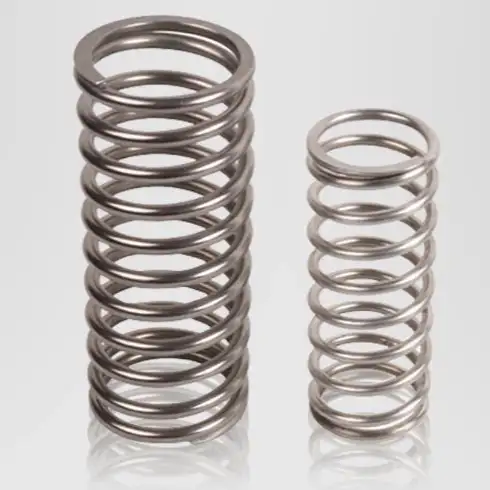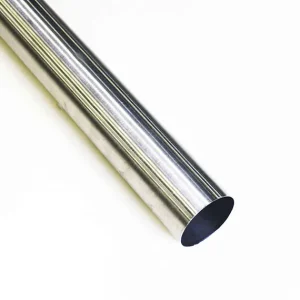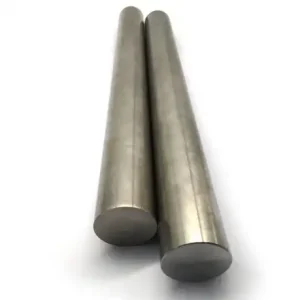For high-performance spring applications that demand exceptional seawater corrosion resistance and high strength, Monel K-500 springs deliver an outstanding combination: corrosion resistance comparable to Monel 400 with markedly higher tensile and yield strength after age-hardening, plus excellent fatigue behaviour when properly heat-treated and manufactured. If your design requires long service in aggressive or saline environments (marine hardware, valve and pump springs, subsea connectors, aerospace fasteners), Monel K-500 is one of the few commercial alloys that will meet both strength and corrosion needs simultaneously.
What is Monel K500 Springs?
Monel K500 springs are precision-engineered components manufactured from a precipitation-hardenable nickel-copper alloy. This specialized spring material contains approximately 63% nickel and 30% copper, enhanced with aluminum and titanium additions that enable age-hardening capabilities.
The alloy designation K500 indicates its enhanced strength characteristics compared to standard Monel 400. Through controlled heat treatment processes, we achieve remarkable mechanical properties that surpass traditional copper-nickel alloys by significant margins.
These springs maintain their structural integrity across temperature ranges from -250°F to 900°F (-157°C to 482°C), making them indispensable for cryogenic applications and high-temperature environments. The material's inherent non-magnetic properties add another dimension of utility in specialized applications.
Manufacturing processes involve cold working followed by age hardening, resulting in springs with exceptional fatigue resistance. The precipitation hardening mechanism creates uniformly distributed strengthening phases throughout the material matrix.
What is the Chemical Composition of Monel K500 Springs?
| Element | Percentage (%) | Function |
|---|---|---|
| Nickel (Ni) | 63.0-70.0 | Primary matrix element, corrosion resistance |
| Copper (Cu) | 27.0-33.0 | Structural component, conductivity |
| Aluminum (Al) | 2.3-3.15 | Precipitation hardening agent |
| Titanium (Ti) | 0.35-0.85 | Strengthening element |
| Iron (Fe) | 2.0 max | Impurity control |
| Manganese (Mn) | 1.5 max | Deoxidizer |
| Carbon (C) | 0.25 max | Carbide formation |
| Silicon (Si) | 0.5 max | Deoxidizer |
| Sulfur (S) | 0.01 max | Controlled impurity |
The precise chemical balance creates synergistic effects that enhance both mechanical performance and environmental resistance. Aluminum and titanium form intermetallic compounds during heat treatment, generating the alloy's characteristic high strength.
What are the Mechanical Properties of Monel K500 Springs?
| Property | Value | Units | Test Method |
|---|---|---|---|
| Tensile Strength | 1100-1300 | MPa | ASTM E8 |
| Yield Strength (0.2% offset) | 750-950 | MPa | ASTM E8 |
| Elongation | 15-25 | % | ASTM E8 |
| Modulus of Elasticity | 179 | GPa | ASTM E111 |
| Shear Modulus | 66 | GPa | ASTM E143 |
| Fatigue Strength (10^7 cycles) | 380-420 | MPa | ASTM D7791 |
| Impact Strength (Charpy V-notch) | 102-135 | J | ASTM E23 |
| Density | 8.44 | g/cm³ | ASTM B311 |
These mechanical characteristics position Monel K500 springs among the strongest available spring materials. The combination of high strength and ductility enables complex spring geometries while maintaining reliability under cyclic loading conditions.
Age-hardened material exhibits remarkable consistency across different section thicknesses, ensuring predictable performance in various spring configurations. The material responds excellently to cold forming operations before heat treatment.
What is the Specification of Monel K500 Springs?
| Specification Type | Standard | Description |
|---|---|---|
| Material Specification | ASTM B865 | Standard specification for Monel K500 |
| Wire Specification | ASTM B164 | Nickel-copper alloy rod, bar, and wire |
| Sheet/Plate Standard | ASTM B865 | Precipitation-hardenable nickel alloy |
| Welding Rod Standard | AWS A5.14 | ERNiCu-7 classification |
| Federal Specification | QQ-N-286 | Military specification |
| UNS Number | N05500 | Unified numbering system |
| DIN Equivalent | 2.4375 | German industrial standard |
| JIS Equivalent | NCu30-2-2 | Japanese industrial standard |
These specifications ensure consistent quality and performance across different manufacturers and applications. Compliance with international standards facilitates global sourcing and quality assurance protocols.
Typical tempering / heat-treat regime for springs
Spring wire is normally supplied in a condition tailored for coiling and final aging. Typical heat-treatment sequence used by spring wire manufacturers and coilers:
-
Solution anneal: dissolve prior precipitates and homogenize (manufacturer process control).
-
Cold drawing / cold working (optional): to reach final wire diameter — increases dislocation density and contributes to final strength after aging.
-
Coil/close-coiling: springs are formed (cold) from wire.
-
Age (precipitation) heat treat (aging): typical aging treatments for K-500 spring temper are in the range ~480–540°C (approx. 900–1000°F) for several hours (specific schedules depend on component size and desired hardness). After aging, the Ni₃(Ti,Al) precipitates provide strength. Exact temperatures/times come from the wire mill’s or coiler’s data sheet and the AMS/ASTM wire specs.
Important: aging must be controlled: under-aging leaves inadequate strength; over-aging can reduce toughness and increase susceptibility to certain stress-corrosion mechanisms. For springs, many suppliers provide a "spring temper + aged" specification so the buyer gets wire or finished springs with a guaranteed tensile/yield/hardness window.
Manufacturing guidelines for Monel K-500 springs
-
Forming speed & work-hardening: Monel alloys work-harden quickly; when forming wire into close coils keep tooling speeds and feeds moderate. Use lubricants suitable for nickel-copper alloys.
-
Stress-relief for coiled springs: perform stress relief / aging after coiling to set the spring and develop the gamma-prime precipitate. For critical springs consider a two-step approach: light stress-relief to reduce residual stresses, then a controlled aging cycle for final strength.
-
Surface finish: K-500 springs used in seawater should have clean, oxide-free surfaces and often a light passivation or inert shipping oil. Avoid leaving machining chips or contamination that might create crevice corrosion sites.
-
Shot peening: recommended on high-fatigue springs to improve mean stress performance — ensure peening parameters are compatible with the alloy’s hardness to avoid surface cracking.
-
Inspection: each batch should be tested for tensile, hardness and surface defects; for critical components request NDT (eddy current, visual QE) and MTC (EN 10204 3.1/3.2 where required).
What is Monel K500 Equivalent to?
Monel K500 shares similarities with several high-performance alloys, though direct equivalencies are limited due to its unique precipitation-hardening characteristics.
The closest equivalents include Inconel X-750 for high-temperature spring applications, though K500 offers superior corrosion resistance in marine environments. Beryllium copper alloys provide comparable strength levels but lack the comprehensive corrosion resistance.
German standard 2.4375 represents the European equivalent designation, maintaining identical chemical composition requirements. Japanese JIS NCu30-2-2 provides another regional equivalent with minor specification variations.
For specific applications, we often compare performance characteristics rather than seeking direct material substitutions. Each application requires careful evaluation of environmental conditions, mechanical requirements, and cost considerations.
What is Monel K500 Standard?
Primary standards governing Monel K500 include ASTM B865 for precipitation-hardenable nickel-copper alloys and ASTM B164 for rod, bar, and wire products. These standards define chemical composition limits, mechanical property requirements, and manufacturing tolerances.
Military specification QQ-N-286 covers defense applications, incorporating additional testing requirements and quality control measures. This specification includes provisions for lot traceability and enhanced material certification.
International standards such as EN 2.4375 and JIS H4551 provide regional compliance frameworks. These standards facilitate international trade while maintaining consistent quality expectations.
UNS N05500 designation provides universal material identification across different standards systems. This unified approach simplifies material specification and procurement processes.
What is the Hardness of Monel K500 Springs?
| Condition | Rockwell C | Rockwell B | Brinell | Vickers |
|---|---|---|---|---|
| Annealed | - | 65-85 | 120-160 | 130-170 |
| Age Hardened | 25-35 | - | 250-350 | 260-370 |
| Cold Worked + Aged | 30-40 | - | 300-400 | 320-420 |
| Spring Temper | 35-45 | - | 350-450 | 370-470 |
Hardness values correlate directly with mechanical strength and spring performance characteristics. Age-hardened conditions provide optimal balance between strength and ductility for most spring applications.
The precipitation hardening response creates uniform hardness distribution throughout cross-sections, eliminating concerns about surface versus core properties. This consistency enables reliable spring design calculations.
What is the Classification of Monel K500 Springs?
| Classification Category | Type | Description |
|---|---|---|
| Alloy System | Nickel-Copper | Precipitation hardenable |
| Strengthening Mechanism | Age Hardening | Al-Ti intermetallics |
| Corrosion Classification | Highly Resistant | Marine environments |
| Temperature Class | Intermediate | -157°C to 482°C |
| Magnetic Properties | Non-magnetic | All conditions |
| Weldability | Good | Specialized procedures |
| Machinability | Moderate | Work hardening tendency |
| Spring Classification | High Performance | Premium applications |
Classification systems help engineers select appropriate materials for specific applications. The precipitation-hardenable designation indicates superior mechanical properties compared to solid-solution strengthened alloys.
Monel K500 Springs Global Market Pricing 2025
| Region | Price Range (USD/kg) | Market Factors | Supply Status |
|---|---|---|---|
| North America | 45-52 | Strong aerospace demand | Stable |
| Europe | 48-55 | Marine industry growth | Moderate |
| Asia-Pacific | 42-48 | Manufacturing expansion | Growing |
| Middle East | 50-58 | Oil & gas applications | Limited |
| South America | 46-53 | Mining sector demand | Variable |
| Africa | 52-60 | Import dependent | Constrained |
Pricing fluctuates based on nickel commodity costs, representing approximately 65% of raw material expenses. Market dynamics reflect regional demand patterns and supply chain considerations.
Current pricing trends indicate steady growth driven by expanding applications in renewable energy and advanced manufacturing sectors. Long-term contracts often provide price stability for large-volume users.
Advantages & disadvantages vs other spring alloys
Vs Monel 400: K-500 has much higher strength after aging while keeping similar corrosion resistance — choose K-500 when strength (and fatigue life) is primary.
Vs 17-7 PH or SAE stainless PH grades: stainless PH alloys can reach similar strengths but generally have poorer seawater corrosion resistance compared to Monel K-500 — K-500 is better for direct seawater exposure.
Vs Inconel (Ni-based superalloys): Inconels (e.g., X-750) give high temperature strength but different corrosion profile; K-500 is preferred in chloride-rich aqueous environments; Inconel is preferred at high static temperatures or aggressive oxidizing atmospheres.
Vs beryllium copper: Be-Cu has excellent fatigue, conductivity and is cheaper in some forms, but it lacks the seawater corrosion resistance of K-500. Use Be-Cu for electrical springs not exposed to aggressive saltwater.
Spanish Procurement Case Study
A leading Spanish renewable energy company recently specified Monel K500 springs for offshore wind turbine pitch control systems. The application demanded corrosion resistance against Atlantic marine conditions combined with reliable mechanical performance over 20-year service intervals.
Initial material evaluation involved extensive testing in simulated seawater environments, comparing K500 performance against conventional stainless steel alternatives. Results showed dramatically superior corrosion resistance with minimal strength degradation after 5000-hour exposure testing.
The procurement specification required ASTM B865 compliance with additional Charpy impact testing at -20°C to ensure cold weather reliability. Material certification included full chemical analysis and mechanical property verification for each production lot.
Installation began in 2024 with 2,400 springs across 12 turbine units. Six-month inspection reports indicate excellent performance with no evidence of corrosion or mechanical degradation. The customer plans expanding K500 spring usage to additional wind farm projects based on initial success.
Cost analysis revealed 40% higher initial material costs compared to stainless steel alternatives, offset by projected 300% longer service life and reduced maintenance requirements.
Frequently Asked Questions
-
Can Monel K-500 springs be used in continuous seawater duty?
Yes — K-500 retains Monel 400’s seawater resistance and is used extensively in pump shafts, marine fasteners and springs. For long submerged service, ensure good surface finishing and consider sacrificial/anodic isolation if in contact with dissimilar metals. -
What is the recommended aging temperature for spring temper?
Typical aging for spring temper is in the ~480–540°C (≈900–1000°F) range for times depending on section size — follow supplier heat-treatment schedules for optimal strength vs toughness. -
Is K-500 magnetic after aging?
K-500 is generally non-magnetic at room temperature; certain cold-working/heat treatments can alter magnetic response slightly, but it is effectively non-magnetic for most engineering uses. -
Which standards cover K-500 wire and bars?
Common standards: ASTM B865 for bar/rod/wire shapes, AMS 4676 for aerospace wire, and ISO/BS equivalents. For pressure code use ASME Code Case 1192 references where applicable. -
How does K-500 behave in sour (H₂S) service?
K-500 is often acceptable but check ISO 15156 / NACE MR0175 limits; age-hardened condition can be sensitive to some chloride/stress environments — always validate with lab testing for sour environments. -
Typical lead time for custom springs from MWalloys?
For stocked sizes: days to weeks; for custom geometries with MTC: lead times depend on MOQ and heat-treatment but MWalloys prioritises fast shipment for stocked wire/springs — contact sales for the exact ETA. (commercial advice) -
What surface treatments improve life?
Shot peening, controlled polishing, and thin protective coatings (if compatible) improve fatigue life — avoid coatings that trap chlorides under crevices. -
How to calculate spring weight for shipping?
Use the wire mass per metre table above and multiply by total wire length in the spring (approx. coil length = mean coil circumference × coils). Use density 8.44 g/cm³ for K-500. -
Is machining K-500 difficult?
K-500 work-hardens; use slow spindle speeds, positive rake tooling, ample cutting fluid and avoid high feed rates. For spring wire forming use appropriate spring-form tooling and lubrication. -
Can MWalloys supply test reports & traceability?
Yes — MWalloys supplies EN 10204 MTCs and full chemical & mechanical certificates on request for mill / heat traceability (recommended for critical orders).





